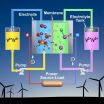The statement appears in the March 15, 2011, American Journal of Respiratory and Critical Care Medicine.
IPF is a chronic, progressive, fatal form of fibrotic lung disease, characterized by shortness of breath during exertion, which occurs primarily in relatively older adults. The etiology of IPF is unclear. The disease occurs when injury to the lungs is triggered by an unknown cause, resulting in the formation of scar tissue that causes the lungs to become thickened and stiff. IPF may progress slowly over several years and may be punctuated by episodes of acute respiratory decline. Lung transplantation is a feasible treatment option in highly selected patients. A subgroup of patients with IPF has a genetic predisposition to the disease.
"In the decade since the publication of the previous statement on IPF, studies have used the criteria for the diagnosis of IPF and recommendations published in the previous consensus-based statement to further our understanding of the clinical manifestations and course of IPF, and there has been an increasing body of evidence pertinent to its clinical management," said Ganesh Raghu, MD, director of the Interstitial Lung Disease/Sarcoid/Pulmonary Fibrosis Program at the University of Washington Medical Center in Seattle and chair of the collaborative committee that drafted the statement. "The accumulated data and observations made in these studies are substantial and have allowed us to provide new guidelines for the diagnosis and management of IPF to the global pulmonary community-at-large to the patients and to all concerned based on evidence for the very first time."
The new guidelines represent a collaborative effort between the ATS, the European Respiratory Society (ERS), the Japanese Respiratory Society (JRS) and the Latin American Thoracic Association (ALAT). In creating the new guidelines, selected experts from each of the groups reviewed all available evidence, ranking it according to clinical relevance. The statement has also been formally endorsed by the Society of Thoracic Radiology and by the Pulmonary Pathology Society.
"The objective of these guidelines is to systematically and carefully analyze all evidence accumulated since the publication of the 2000 consensus statement and to provide evidence-based recommendations for management, with an emphasis on diagnosis and treatment," said Dr. Raghu, who is also the medical director of the University of Washington's lung transplant program.
"The methodology used and the strength of the recommendations are all very transparent and thus the clinician confronted with the patient with IPF is empowered for the very first time to make the most appropriate decisions tailored to individual patient's values and preferences, and to make appropriate decisions regarding all aspects of disease management," he noted.
The recommendations in the guidelines are ranked from weak to strong to help the clinician understand the strength of the recommendations made in managing patients with IPF.
"For example, in the case of a weak recommendation clinicians are especially required to spend adequate time with patients to discuss patients' values and preferences. This may lead a significant proportion of patients to choose an alternative approach," Dr. Raghu said.
ATS Public Advisory Roundtable Chair Teresa Barnes said, "Fully informed patients are in the best position to make decisions that are consistent with the best evidence and their values and preferences.
"However," Ms. Barnes, who is vice president of patient outreach and advocacy at the Coalition for Pulmonary Fibrosis added, "every physician when communicating with a patient with IPF must be prepared to spend as much time needed to help patients understand the uncertainties and potential consequences of a treatment regimen, especially those with a weak recommendation."
To assist clinicians in their interactions with IPF patients and their families, the ATS has developed a companion patient information series piece on IPF that is also published in the March 15 journal. This education piece will be posted on the ATS Web site (www.thoracic.org), as well as the Web site of the Coalition for Pulmonary Fibrosis (www.coalitionforpf.org), an ATS Public Advisory Roundtable member organization, whose focus is on research, advocacy, support and education for the pulmonary fibrosis community.
In addition to offering guidelines for diagnosis and management of IPF patients, the statement also offers suggestions for future studies of the disease.
"It is hoped that with continued collaboration between basic and clinical scientists, the goals of finding the cause or causes of IPF, detecting disease in preclinical and early stages by appropriate biomarkers, genetic predisposition and/or other host susceptibility factors, improving outcomes and quality of life, prolonging survival and, ultimately, curing IPF will be realized," Dr. Raghu said.
Genetic studies and preventive and regenerative strategies, including stem cell transplant research and gene therapy, hold promise and should be aggressively pursued, he added.
"The committee believes that successful treatment of IPF will require a combination of therapies targeting multiple pathways involved in the fibro proliferation," Dr. Raghu said. "Future clinical trials should incorporate endpoints of proven clinical value, utilize sophisticated study design and statistical methodology, investigate the impact of potential preventive measures and consider combinations of promising therapies that work through distinct mechanisms.
"While this evidence-based guidelines for clinical management of IPF are prudent for better management of patients with IPF in 2011 and immediate future, this guideline does not address the optimal endpoints besides survival that need to be assessed in future clinical trials for IPF," he said. "Ideally, a consensus among experts in the regulating agencies and experienced investigators in clinical trials of IPF will lead to design of better clinical trials that are feasible and result in improved survival, quality of life and other outcomes that are clinically significant for patients with IPF. The new diagnostic criteria provided in this new guideline will greatly enhance the accuracy of the diagnosis of IPF and facilitate enrollment of patients with well and better defined IPF in future studies and thus make more progress than the preceding decade."
INFORMATION:
END

